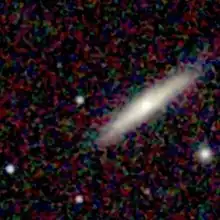| NGC 52 | |
|---|---|
 NGC 52 and nearby PGC 1563523 (lower right) as seen on legacy survey | |
| Observation data (2000.0 epoch) | |
| Constellation | Pegasus |
| Right ascension | 00h 14m 40.2s [1] |
| Declination | +18° 34′ 48″ [1] |
| Redshift | 0.017986 |
| Heliocentric radial velocity | 5390 km/s |
| Distance | 243,000,000ly[2] (73,000,000 Parsecs)[3] |
| Apparent magnitude (V) | 14.6 [4] |
| Characteristics | |
| Type | Sc [2] |
| Size | 150,000[2] |
| Apparent size (V) | 2.6' × 0.5' [1] |
| Other designations | |
| UGC 140, CGCG 456-042, CGCG 12.0+1817, MCG+03-01-030, 2MFGC 00177, 2MASX J00144010+1834551, 2MASXi J0014401+183455, IRAS 00120+1818, IRAS F00120+1818, AKARI J0014401+183453, LDCE 0011 NED002, PGC 978, UZC J001440.2+183454, NVSS J001440+183455 [5] | |
NGC 52 (PGC 978) is an edge-on spiral galaxy in the constellation Pegasus. It was discovered on September 18, 1784, by William Herschel. He described it as "very faint, small, extended."[2]
Physical characteristics
The galaxy is approximately 150,000 light years across.[2] This makes it, in comparison, about 1.5 times as large as the Milky Way. The galaxy also has a satellite elliptical galaxy called PGC (Principal Galaxies Catalogue) 1563523.
See also

NGC 52 (2MASS)
References
- 1 2 3 "NGC 52 - DeepSkyPedia :: Astronomy". Archived from the original on 2014-12-05. Retrieved 2013-08-14.
- 1 2 3 4 5 "New General Catalog Objects: NGC 50 - 99". Retrieved 2013-08-14.
- ↑ "parsecs to lightyears conversion". Retrieved 2013-08-14.
- ↑ "Category:NGC 52 - Wikimedia Commons". Retrieved 2013-08-14.
- ↑ "Your NED Search results". Retrieved 2013-08-14.
External links
 Media related to NGC 52 at Wikimedia Commons
Media related to NGC 52 at Wikimedia Commons- NGC 52 on WikiSky: DSS2, SDSS, GALEX, IRAS, Hydrogen α, X-Ray, Astrophoto, Sky Map, Articles and images
- SEDS
This article is issued from Wikipedia. The text is licensed under Creative Commons - Attribution - Sharealike. Additional terms may apply for the media files.